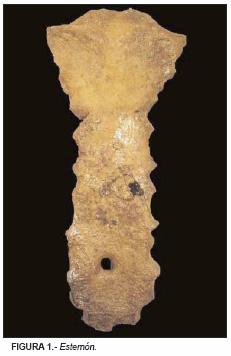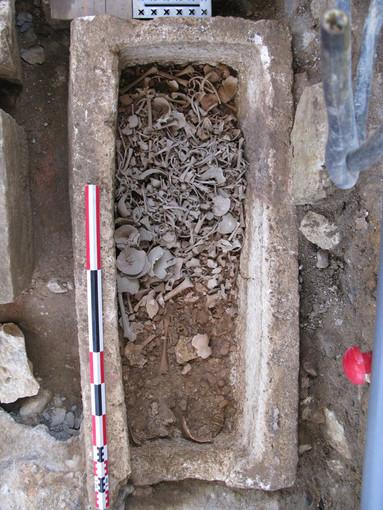Katy Meyers
Source - http://www.bonesdontlie.com/

Sternal foramen is an example of a non-metric trait, via UFL
There used to be an assumption within archaeology that people who were buried within the same grave or same necropolis were related to one another. In geography, we call this Tobler’s First Law: ”Everything is related to everything else, but near things are more related than distant things”. This concept in archaeology was especially prevalent among double burials of an adult female and subadult or neonate. It was often assumed that this represented a mother and her child who had died at the same time. However, as DNA studies become more common, it has been increasingly found that subadults may have been buried with any adult that died around the same time as them. Further, the spatial relationships between people may be household relationships rather than kin relationships, with the former consisting of broadly familial, friend and servant relations who lived and worked within the same house.
In order to determine relatedness, there are two methods we can employ. The first is more traditional and involves using cranial and post-cranial non-metric traits. This means looking at how physically similar individuals are, specifically whether they all possess certain unique skeletal traits like the presence of notches, holes or extra bones that don’t impair function but are unique. If you’d like to see a great discussion on these traits, check out Spoilheap’s creator Sue Anderson’s MPhil thesis available freely online: Chapter Five: Non-metric Traits. However, recent studies have demonstrated that while these traits have the potential to find relationships when genetic data is not available, they are less effective in determining close familial relations and are best used for broader related groups. The second method, which is more reliable, is the use of DNA to specifically determine parental relationships. Conducting DNA studies requires careful handling of bones to prevent contamination with modern DNA, and great preservation of the remains.

Example of a Merovingian sarcophagus burial from Angers, Photo by M. Pithon, via Inrap
A new study by Deguilloux et al. (2014) examines the kinship patterns of a group of skeletons from a Merovingian period necropolis. The necropolis and its associated church were in use from the 7th to 11th century AD, and was found in Jau-Dignac et Loirac, in southwest France. The site included 54 sepulchres, small burial spaces cut into walls, and 20 sarcophagi, stone burial containers, that were closely grouped within and outside the church. They found that in the western portion of the necropolis there was a high degree of uniformity in the non-metric traits found within the individuals. Further, the sarcophagi within this portion were grouped together, in alignment, used during the same period, and had very similar funerary practices. Most interesting, was that the sarcophagi here were reused over several generations and included 2-4 individuals. This led them to believe that this grouping was potentially part of the same family. A DNA study was done in order to determine their relationships to one another.
Genetic study was undertaken based on nuclear STRs (Short Tandem Repeats, used to compare specific locations on DNA) and mtDNA (mitochondrial DNA, used primarily to determine maternal relationships) analysis on 9 skeletons buried in 3 sarcophagi. In order to preserve the DNA, careful precautions were taken during sampling and analysis to prevent contamination. The were able to extract DNA from the teeth of all 9 individuals including 3 older adult males, 2 young adult females, 2 teen females, 1 unknown teen, and an infant. They were able to get useable mtDNA from 8 of the 9 individuals, but no useable STRs due to degradation of the bone. They identified 6 different mitochondrial lineages, indicating that the site might have been used by a social group with high genetic diversity or high levels of gene flow with surrounding populations. They found that there were maternal relationships between two individuals from sarcophagus 169 and two individuals from sarcophagus 170. This doesn’t mean that the other individuals from the third
sarcophagus are unrelated, but may mean that they were related through the father’s side. Deguilloux et al. (2014) proposes that the reuse of sarcophagi within this necropolis was a result of the individuals’ kinship. An interesting conclusion was that the infant was not related to the female individuals found within the sarcophagus. They conclude that the whole site was likely constructed for a specific aristocratic group in this period, and that the necropolis would have been used by one specific family within this group.
This is a very interesting study, and it shows the importance of being careful about making assumptions regarding family relationships. First, family doesn’t necessarily mean biologically related as adoption was plausible during this period, especially with higher status groups. Second, the lack of maternal DNA doesn’t mean unrelated, but rather may mean relationship through the paternal side of the family. Finally, the appearance of infants doesn’t mean that they are specifically related to one of the females. As DNA studies become more common, it will be interesting to see how our interpretations change further.
Works Cited
M.F. Deguilloux, M.H. Pemonge, F. Mendisco, D. Thibon, I. Cartron, & , D. Castex a (2014). Ancient DNA and kinship analysis of human remains deposited in Merovingian necropolis sarcophagi (Jau Dignac et Loirac, France, 7th-8th century AD) Journal of Archaeological Science DOI: 10.1016/j.jas.2013.09.006